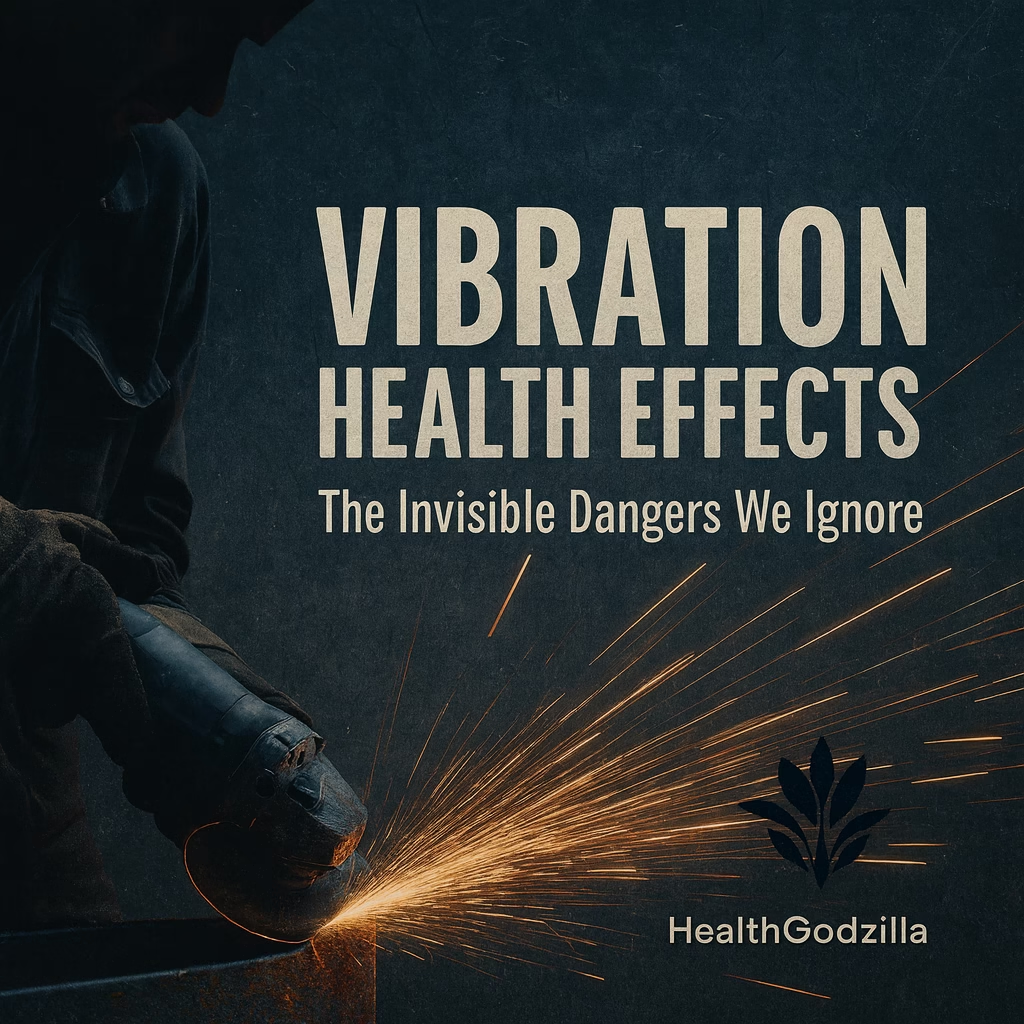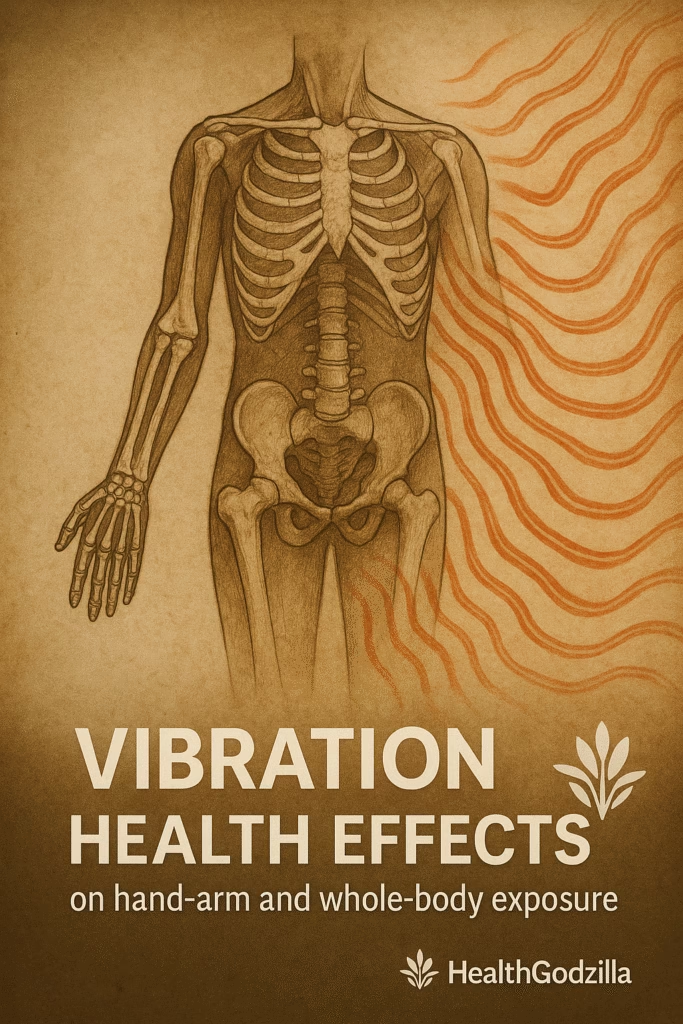
Prologue – The Silent Tremor
Not all injuries roar. Some hum through steel, others whisper in the spine. These are the beginnings of vibration health effects—an unseen force that enters quietly and stays.
Vibration is an invisible companion of work.
It hides in the buzz of the grinder, the rattle of a jackhammer, the steady shudder of a tractor across uneven ground. The National Institute for Occupational Safety and Health (NIOSH) describes how such exposures reach workers in transportation, construction, mining, and agriculture.
It settles into the back of the bus driver, the wrists of the welder, the fingers of the forest worker holding a saw in winter cold. It is energy, oscillation, a force that does not cut or burn, yet inscribes itself slowly, deeply, into the body.
The danger is not always immediate.
A worker may rise each morning, grip the same tool, steer the same vehicle, and feel only fatigue.
But over weeks, months, years—the hum thickens into pain, numbness, weakness.
Fingers blanch. Backs stiffen. Blood hesitates in its flow.
The body becomes a tuning fork, resonating not with music, but with a memory of machines.
This is the story of vibration in the workplace:
an unseen force, a slow injury,
an echo that lingers in bones and nerves long after the tools have fallen silent.
Act I – The Hand as Witness
The hand is often the first to bear witness.
Where the machine meets the body, vibration enters—through palms, knuckles, tendons—until the hand itself begins to tell a story written in tremors.
At first, it is only discomfort: a dull ache after long hours, a tingling that fades with rest. But the ache returns, and the tingling lingers. Over time, the fingers blanch in the cold, drained of color as if blood has forgotten the path home. This is Hand-Arm Vibration Syndrome (HAVS), one of the most recognized vibration health effects—a condition that turns warmth into whiteness, touch into numbness, grip into weakness. According to the Canadian Centre for Occupational Health and Safety, vibration-induced white finger is among the earliest signs of hand-arm vibration syndrome.
Workers know it by many names: white finger, dead finger, Raynaud’s phenomenon of occupational origin. But whatever the name, the body records the same truth: vibration reshapes the vessels that feed the fingers, the nerves that sense the world, the muscles that grasp a tool.
The progression is slow, almost stealth-like. Pain becomes injury; injury deepens into disease. What begins as fatigue ends as disability, leaving hands less dexterous, less reliable, less able to hold the very tools that brought them here.
To measure its severity, physicians speak in stages—the Stockholm Workshop classification.
- In the vascular map: fingers move from no attacks, to mild blanching at the tips, to moderate whitening across the middle, until severe episodes turn the whole digit pale and lifeless, skin itself altered.
- In the sensorineural map: numbness flickers on and off, grows persistent, erases tactile discrimination, until even the simple act of threading a needle or buttoning a shirt becomes a struggle.
The risk does not lie in the hand alone. It lies in the trades where hands are extensions of steel. Construction workers with percussive hammers, metalworkers at grinders and rotary tools, foresters wielding chainsaws, miners breaking rock, farmers driving vibrating machinery—all carry this burden.
In these calloused hands, vibration writes its signature slowly but firmly. What once was strength turns fragile, what once was grip becomes slip, what once was skill dissolves into pain. The hand, our first witness, bears silent testimony to the unseen tremor.
Act II – The Spine as Resonator
If the hand is the first witness, the spine is the chamber where the tremor echoes deepest.
Every mile of rough road, every jolt of heavy machinery, every hour in a vibrating cab leaves its mark not in sudden collapse but in a gradual wearing down—a slow chiseling of bone, muscle, and nerve.
Whole-body vibration (WBV) does not shout. It begins quietly—fatigue settling in the shoulders, a headache that grows with the journey, a fleeting shakiness when the engine stops. These are short-term murmurs of vibration health effects, often shrugged off as part of the job. But with years, they gather weight. The back stiffens. Sciatic pain radiates down the leg like a hidden fault line. Musculoskeletal strain becomes companion, not visitor. The International Labour Office provides diagnostic and exposure criteria that guide prevention across industries.
Studies of drivers and machine operators tell the same story: the seat is no barrier, the cab no shield. Truck drivers on long highways, tractor operators in furrowed fields, heavy equipment operators in mines and construction—all become conduits for vibration. What seems like motion beneath the wheels translates into motion within the body, aligning poorly with posture, twisting with long hours, tightening with fatigue.
And the harm does not pause at the spine. Circulatory changes stir silently, digestive unease appears, respiratory strain joins in. The body, forced to carry oscillation day after day, finds itself disordered from within.
No single factor explains it fully. Vibration alone is not the sculptor; posture, ergonomics, long hours, even the absence of rest all add their strokes. Together, they carve a burden that is often blamed on age, lifestyle, or chance. But behind many aching backs and weary lungs stands the same quiet culprit: the body made into a resonator for the hum of work.
Act III – Beyond the Localized Tremor
Vibration is rarely content to stay in one place.
What begins in the hand or spine ripples outward as systemic vibration health effects, stirring organs, bending vessels, and unsettling nerves. The body, after all, is not a collection of separate parts—it is one resonant system, tuned by evolution to certain frequencies. When the machine intrudes with its own rhythms, organs themselves can fall out of tune.
The evidence grows unsettling. Cardiovascular disease, once blamed only on diet or inheritance, now shows stronger ties to long exposure to whole-body vibration. Circulatory systems tire; blood flow falters. Neuropathies emerge as nerves lose their fidelity, dulled by repeated shock. Links have also surfaced to diabetes mellitus type 2 and metabolic syndrome, where the body’s chemistry seems to bend under the weight of mechanical oscillation. Even prostate cancer has entered the conversation—its connection debated, but its shadow lingering in the studies. Research reviewed by Krajnak (2018) suggests links between vibration and cardiovascular, metabolic, and neurological disorders.
And vibration does not arrive alone. The miner inhales dust, the farmer breathes pesticides, the truck driver rides through diesel fumes. Co-exposures layer upon each other, each multiplying the harm of the other. What might be tolerated in isolation becomes dangerous in chorus.
Noise too plays its part. Studies reveal that workers already marked by vibration-induced white finger suffer greater hearing loss than their peers exposed to the same level of noise. The explanation is unclear, but the consequence is certain: vibration and sound together wound deeper than either does alone.
The lesson is not only biological but almost musical. The body is like an instrument—its bones, vessels, and nerves resonating within narrow bands of frequency. When outside forces impose new rhythms—100 to 300 hertz in the hand, 5 to 10 in the spine—the harmony becomes distortion, and distortion becomes disease. What was once music becomes damage, carried in silence long after the machines have stopped.

Act IV – Diagnosis, Thresholds, and Laws
If the body is an instrument, medicine becomes the listener—leaning close to catch the subtle notes of damage before they crescendo into disability. Diagnosis begins not with machines but with history, the worker’s own account: years of gripping tools, the first tingling in the fingertips, the slow stiffening of the back.
From there, science adds its measures. Neurosensory tests trace the fading thresholds of touch, temperature, and vibration itself. Vascular tests listen for the spasms that drain blood from the fingers in cold air. Differential diagnoses help distinguish vibration health effects from other causes—autoimmune disease, diabetes, connective tissue disorders. Each step asks: is this tremor truly occupational, or born of some other storm?
The language of thresholds follows. Researchers speak of dose-response curves—how severity bends upward as exposure lengthens or intensifies. They speak of latent periods, months or years between the first encounter and the first symptom, a silence before the sound. Beneath these measures lies the concept of a threshold value—the level of vibration below which most healthy workers may endure a lifetime without disease. But even here, exceptions whisper: not every body is equally tuned, not every worker equally spared.
To guard against this, standards emerge like sheet music for prevention.
- The American Conference of Governmental Industrial Hygienists (ACGIH) sets Threshold Limit Values (TLVs), lines beyond which risk grows sharp.
- The European Directive 2002/44/EC prescribes action values—2.5 m/s² A(8) for hand-arm vibration, 0.5 m/s² A(8) for whole-body—and exposure limits of 5.0 and 1.15 respectively. Cross those boundaries, and intervention is no longer optional but law.
Yet the law, like music, only matters if it is heard. Surveillance becomes the quiet rehearsal, checking workers year by year, tool by tool, posture by posture. Early recognition is key: to catch blanching before fingers turn white, to note fatigue before the spine stiffens, to hear the faint discord before it becomes permanent silence.
Thus diagnosis, thresholds, and laws form not just a framework of compliance but a way of listening—to bodies, to machines, to the fragile harmony between them.
Act V – Prevention and Control
Yet the law, like music, only matters if it is heard.
And so prevention becomes the conductor’s task: to lower the volume of harm, to re-tune the instruments of labor before the melody turns to noise.
The first notes are engineering. Machines can be built to hum less harshly—low-vibration tools, their handles cushioned, their motors balanced. Vehicles can be fitted with better damping, suspension seats designed to absorb the jolt, tyres chosen to soften the road’s percussion. Even the earth beneath—worksites, unpaved roads, fields—can be leveled and maintained to quiet the shocks before they rise into the body. Such steps are essential to reduce vibration health effects, and the European Agency for Safety and Health at Work (EU-OSHA) provides detailed guidance on these preventive measures.
Then comes the rhythm of administration. Exposure time is counted like beats on a score. Rotate the players, shift the tasks, insert pauses. Job rotation limits how long one body bears the burden. Short breaks between shifts let tired muscles recover before lifting or gripping again. Training ensures workers don’t over-grip tools or force them too hard, mistaking pressure for efficiency.
Personal measures play a quieter role. No glove can truly still the tremor, though some claim to. What they can do is keep warmth in the fingers, keeping blood flowing in the cold where vibration and frost conspire. Clothing that guards against damp and chill helps preserve circulation, reducing one enemy even if it cannot silence another.
Above all, prevention must remain worker-centered. The solutions that endure are not those imposed from afar, but those shaped in dialogue—between operator and engineer, between driver and mechanic, between worker and health officer. Practical strategies that consider the real rhythms of a workday, the actual strains of a shift, are the ones that last.
In the end, prevention is not silence but harmony. It cannot erase vibration entirely—machines will always hum, engines will always shake. But it can soften the dissonance, adjust the tempo, ensure that the music of work is one the body can still play without breaking.
Epilogue – The Worker’s Legacy of Oscillation
When the shift ends and the machines fall quiet, the body does not.
The hum lingers—subtle, persistent—a silent memory etched into bones, nerves, and vessels. It is a memory without words, carried in the way a hand struggles to button a shirt, or a back stiffens rising from a chair.
Vibration does not vanish with the switch of a tool; it remains inside, like an aftertone that refuses to fade. Each oscillation absorbed by the hand, each jolt borne by the spine, becomes part of the worker’s own resonance. Years later, even in silence, the echoes stir.
The body is an instrument mistuned. Fingers blanch in cold air, nerves misfire in sudden numbness, the spine carries a rhythm of pain that no song intends. And though the machine may be gone, its music remains—unwanted, unfinished—played on flesh instead of steel.
This is the legacy of vibration: not a visible scar, not a wound easily shown, but a hidden oscillation carried forward. A tremor that begins in tools and engines, yet ends in the very architecture of the body—an enduring mark of vibration health effects written into nerves and bone.
🍂 Hello, Artista

The evening bus in Vancouver hummed as Artista leaned back, the seat trembling with each turn of the engine. Whitee and Brownie would be waiting at home, but for now the hum was company—steady, low, almost like the bass of a forgotten song.
Far away in Boston, Organum descended into the subway. The train lurched forward, wheels shrieking, the cars rattling. He smiled faintly; the dogs—RD, MD, Barku, and Gulli—never liked this sound. To him, the vibration was a memory of youth, but also a reminder of how long the spine remembers what machines demand.
They spoke across distance, as they often did.
“Funny, isn’t it?” Artista mused. “Music is vibration too. The right tremor can heal—drums in ceremony, strings in symphony, even the hum of lullabies. Yet here, in this bus seat, it feels more like erosion than comfort.”
Organum answered, voice carrying the weight of subway echoes: “Yes. When vibration is chosen, it becomes harmony. When imposed, it becomes fatigue. Our bodies can’t always tell the difference, but our spirits do.”
For a moment, silence. Only the hum of engines, the rattle of tracks.
Then Artista asked the question that neither could answer, the one that lingered beyond their words:
“When does vibration become song, and when does it become wound?”
✍️ Author’s Reflection
I was not alone when I wrote this. Others spoke, and I listened. The voices of workers whose hands ache in winter, whose backs hum with the memory of engines, whose bodies remember what laws too often forget.
Vibration health effects are not only a matter of mechanics, thresholds, and exposure limits. They are a reminder that the body holds echoes long after machines are silent. A reminder that our tools may outlast us, but not without leaving their song inside us.
I think of Whitee and Brownie, soft and watchful in Vancouver, and of RD, MD, Barku, and Gulli in Boston—living beings who hum only with life, not with harm. They remind me that not all tremors wound. Some are simply the quiver of joy when a rabbit darts, or the shiver of a dog’s tail beating against the floor.
Between these harmless vibrations and the harmful ones lies a question we cannot escape: how long can we let the hum of industry write itself into the nerves of workers before we finally hear it?
—Jamee
🌼 Articles You May Like
From metal minds to stardust thoughts—more journeys await:
- AOL-Time Warner failure: Merger, mindsets, and market myths. Explore culture clash, transient advantage, primacy, and antitrust risks.
- Beryllium exposure risks chiefly in high-tech and heavy industries. Covering workplace hazards, chronic disease, global updated guidelines.
- Biodiversity and nutrition: Reforming diets through agrobiodiversity. Policy, Traditional and Indigenous Foods, and Scientific Relevance.
Curated with stardust by Organum & Artista under a sky full of questions.
📚 Principal Sources
- Niu, S., Colosio, C., Carugno, M., & Adisesh, A. (Eds.). (2022). Diagnostic and exposure criteria for occupational diseases: Guidance notes for diagnosis and prevention of the diseases in the ILO list of occupational diseases (Revised 2010). International Labour Office.
- Canadian Centre for Occupational Health and Safety (CCOHS). (2024, March 26). Vibration – Health effects.
- Krajnak, K. (2018). Health effects associated with occupational exposure to hand-arm or whole-body vibration. Journal of Toxicology and Environmental Health, Part B: Critical Reviews, 21(5), 320–334.
- European Parliament, & Council of the European Union. (2002). Directive 2002/44/EC of the European Parliament and of the Council of 25 June 2002 on the minimum health and safety requirements regarding the exposure of workers to the risks arising from physical agents (vibration) (sixteenth individual Directive within the meaning of Article 16(1) of Directive 89/391/EEC). Official Journal of the European Communities, L 177, 13–20.
Relevant chapters and sections were interpreted through a narrative lens rather than cited academically.

Leave a Reply